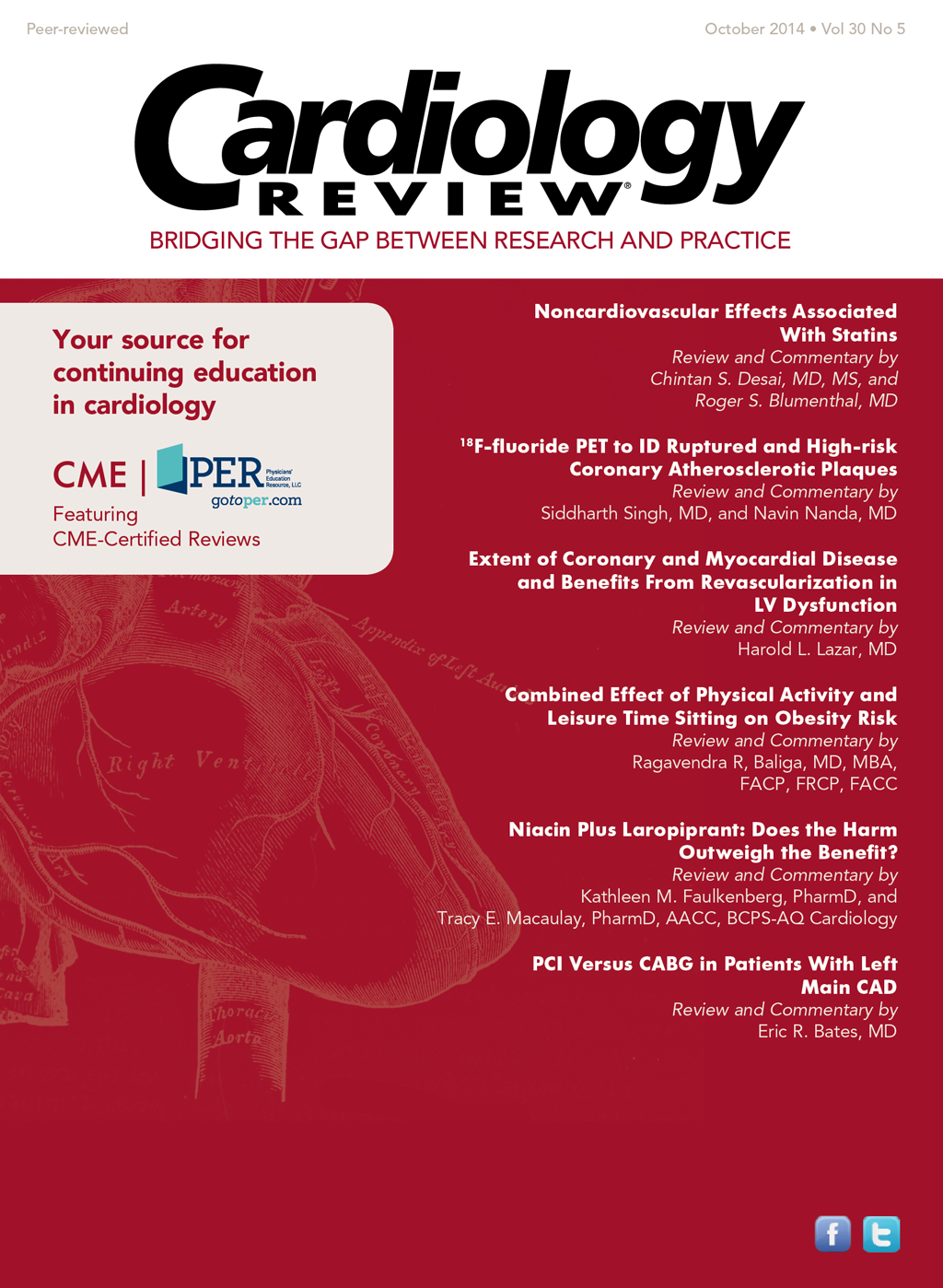Publication
Article
Cardiology Review® Online
Niacin Plus Laropiprant: Does the Harm Outweigh the Benefit?
Is the final word on high-dose niacin finally in?
Review
N Engl J Med
The HPS2-THRIVE Collaborative Group. Effects of extended-release niacin with laropiprant in high-risk patients. . 2014;371:203-212.
N Engl J Med
The HPS2-THRIVE Collaborative Group. Effects of extended-release niacin with laropiprant in high-risk patients. . 2014;371:203-212.
Existing cardiology treatment guidelines recommend the use of nonstatin therapy, such as niacin, in patients who have a poor response to or are intolerant of statin therapy.1 This recommendation remains in place despite the lack of randomized controlled trials supporting the use of niacin for reduction of major cardiovascular events. An earlier trial studying high-dose extended-release (ER) niacin in patients with cardiovascular disease and low high-density lipoprotein (HDL) cholesterol funded by the National Institutes of Health (NIH) was stopped early because of an apparent lack of benefit.2 However, the study authors and the NIH remained optimistic about the niacin hypothesis, attributing the low event rates in both arms to an underpowered study that was unable to demonstrate a difference in the primary outcome.
Another important consideration with use of niacin in the treatment of hyperlipidemia is its less than desirable side effects, which often leads to discontinuation by patients because of the undesirable adverse effect of flushing.3 The mechanism of this reaction involves cyclooxygenase-mediated formation of prostaglandin D2 and E2.4 Formulating niacin with laropiprant, a prostaglandin D2 antagonist, was aimed at reducing the incidence of flushing, thereby increasing patient adherence to lipid-lowering therapy with niacin.
Study Design
The Heart Protection Study 2—Treatment of HDL to Reduce the Incidence of Vascular Events (HPS2-THRIVE) was a randomized, double-blind, multicenter trial across the United Kingdom, Scandinavia, and China. Specifically, the trial compared the combination of niacin ER with laropiprant, while on an effective statin-based regimen, to placebo in patients with a history of atherosclerotic disease. Atherosclerotic disease was defined as past myocardial infarction, cerebrovascular disease, peripheral arterial disease, or diabetes with coronary artery disease. Subjects were included in the study if they had a prior history of atherosclerotic disease (ie, myocardial infarction, peripheral arterial disease, or diabetes with symptomatic coronary disease) and were between the ages of 50 and 80 years, regardless of baseline lipid levels. The majority of patients enrolled had coronary disease (78.4%); other prevalent conditions in the patient population were cerebrovascular disease (31.8%), peripheral arterial disease (12.5%), and diabetes (32.3%). Average baseline low-density lipoprotein (LDL) and HDL levels, respectively, were 63 mg/dL and 44 mg/dL.
Prior to randomization, patients were enrolled in a run-in phase (N = 42,424), which included treatment with simvastatin 40 mg/d plus or minus ezetimibe based on previous statin regimen or LDL level >135 mg/dL after 4 weeks. A total of 11.2% of patients withdrew after this phase of the trial. Once the run-in regimen was established, all participants received a combination tablet of 1 g extended-release (ER) niacin plus 20 mg laropiprant daily for 4 weeks followed by 2 g ER niacin plus 40 mg laropiprant for 3 to 6 weeks. A total of 33.1% of patients withdrew after this phase of the trial, primarily due to skin-related, gastrointestinal, diabetes-related, and musculoskeletal adverse reactions. Patients were then randomized (N = 25,673) to receive 2 g ER niacin plus 40 mg laropiprant per day or matching placebo. The follow-up point was 3 months, 6 months, and every 6 months thereafter for a total of 4 years.
P
P
The primary study outcome was the incidence of first major vascular event, classified as a nonfatal myocardial infarction, death from coronary causes, stroke of any type, or coronary or noncoronary revascularization. There was not a significant reduction in the incidence of major vascular events (rate ratio, 0.96; 95% CI, 0.9-1.03; = .29) between the niacin-laropiprant versus placebo at 1 year after randomization (rate ratio, 1.01; 95% CI, 0.90-1.14) or in any years thereafter (rate ratio, 0.94; 95% CI, 0.87-1.02; = .17).
P
Patient adherence to the study drug regimen was assessed at each follow-up, and compliance was defined as 80% adherence. At the end of the first year, participants’ self-reported adherence to the study regimen averaged 89.1%, which decreased to 69.9% by the end of the follow-up period. Of note, patients in the study group had a significantly higher degree of discontinuation compared with the placebo group (25.4% vs 16.6%; <.001), which was largely attributed to the side effects of niacin.
P
P
Secondary outcomes included components of the primary outcomes, different stroke types, and mortality. There were no significant differences between groups on the incidence of individual components of the composite outcome with the exception of a significant 10% relative reduction in arterial revascularization procedures (rate ratio, 0.9; 95% CI, 0.82-0.99; = .03). While there was a 9% increase in risk of death from any cause within the experimental group, it was not significantly different (rate ratio, 1.09; 95% CI, 0.99-1.21; = .08).






